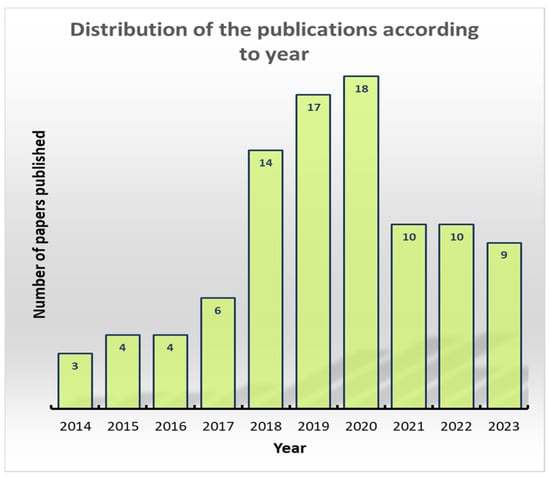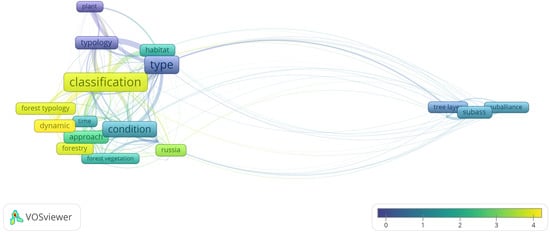Abstract
The success of forest management depends to a large extent on the ecological classification on which it is based. The aim of this work is to review the current status of forest management, priority lines of development, and unresolved problems in genetic and dynamic forest typologies. Papers were searched using the national database Elibrary. We selected and analyzed 94 journal articles with a DOI from the last 10 years. It has been established that the primary scientific focus of genetic and dynamic forest typologies remains the formulation of a conceptual framework for the comprehensive representation of forest dynamics. This evidence demonstrates that, in the context of contemporary global change, these typologies offer the most robust foundation for sustainable forest management. It has been proven that these typologies are currently being developed in parallel, with an emphasis on building on their scientific basis and integrating the strengths of the European Forest Ecological Classifications and the Braun-Blanquet approach. The results of this research can be used to provide the scientific basis for the study and classification of boreal vegetation, as well as the scientific basis for sustainable forest management and reforestation.
1. Introduction
The success of forest management depends to a large extent on the ecological classification on which it is based [1]. Identifying a reliable scientific basis for sustainable forest management and biodiversity conservation is of great importance for European countries [2] and North America [3], as well as for the Russian Federation [1]. The possibility of obtaining extensive data on the structure of forests (including through the use of GIS technologies) has ushered in the era of big data, creating new opportunities for monitoring the state of forest ecosystems, which has exacerbated the problem of structuring the continuously arriving data. In this regard, improvements to the theoretical foundations of forest sciences and the development of new methods for forest inventory and classification, including the use of IT technologies to analyze large amounts of data, are becoming increasingly important [4]. Understanding the processes taking place in forests, the success of biodiversity conservation, and the organization of sustainable forest management largely depend on solving this problem. Therefore, the generalization of modern knowledge on this issue is extremely important in order to compare the results of different regional forest classifications and to develop new hierarchical forest typological schemes and other practical applications, as well as to develop the concept of a unified forest ecological classification at the country level. The purpose of this work is to review the current state of this area, priority lines of development, and unresolved problems in the original directions of ecological classification: genetic and dynamic forest typologies.
2. Methods
Papers were searched using the national database Elibrary. The choice in favour of a national database was made because most of the papers dealing with genetic and dynamic forest typologies are mainly intended for Russian readers and are mainly published in regional journals that are not indexed in WoS. However, the scientific results of these typologies are important for the entire boreal zone. Therefore, our research will undoubtedly be of interest to an international audience. The aim of the search was to identify all forest typology studies carried out in the Russian Federation in the last 10 years (2014–2023). We used the keywords “forest typology”, “forest typologies”, and “forest classification” for the automatic search. Data collection was carried out from 1 June to 20 August 2024. We then selected 94 papers on genetic and dynamic forest typologies and other forest classification approaches that met the established quality criteria. The papers had to have a DOI and an abstract in English. The analysis was performed according to the PRISMA guidelines [5] and using VOSviewer software (version 1.6.18) [6].
3. Results
Genetic and dynamic forest typologies aim to take into account the dynamics of forest vegetation (Figure 1). Therefore, in today’s changing world, these typologies provide the best basis for sustainable forest management in the Russian Federation. Since its inception, genetic forest typology has focused on the study and classification of forests with complex structure and dynamics and the use of new data analysis methods [7,8]. The dynamic forest typology was originally developed to classify the disturbed vegetation of northern areas, which have relatively simple structures and dynamics [9].

Figure 1.
Comparison of genetic and dynamic forest typologies [7,8,9].
We assumed that the distribution of publications by year would show an increase in publication activity in this area, as it is necessary for forestry. However, this is not the case (Figure 2). The number of publications is not increasing, although researchers are still interested in forest typology.

Figure 2.
Distribution of the publications according to year.
Keyword analysis allows the identification of the most important research areas and questions that researchers are looking for answers to. This research analysis showed that genetic and dynamic forest typologies have begun to have a lot in common. Figure 3 does not distinguish between the different forest typologies. For example, taking into account the dynamics of vegetation in forest typological units when classifying forests is the main scientific direction for both the genetic typology and the dynamic typology (Figure 3). The current priority research areas in genetic and dynamic forest typology are the improvement of the conceptual and methodological bases of forest dynamics accounting in classification units; the development of systems for the regional classification of disturbed territories for their restoration; and the improvement of the methodology for identifying forest types based on the remote sensing of territories and modern data analysis methods.

Figure 3.
A network of keyword relationships. The coloured highlighting indicates the average number of Crossref citations of papers related to that keyword.
In Figure 3, a cluster associated with the application of the Braun-Blanquet approach [10] to forest typology occupies a separate position. The Braun-Blanquet approach is an excellent method of ecological analysis and is well suited for identifying the diversity of different types of vegetation; solving theoretical problems of modern vegetation science and can provide a reliable scientific basis for developing solutions to conserve the biodiversity of plant communities [11]. This approach is used in both dynamic forest typology and genetic forest typology.
The citation analysis showed that 52% of the papers included in the analysis were cited at least once. The most frequently cited papers include five papers [12,13,14,15,16]. Another area of forest typology should be mentioned here, namely, Pogrebnyak’s forest typology, which continues to be developed and used, and articles devoted to this area of forest typology are well cited [17]. Our additional special studies have shown that the Ellenberg and Landolt indicator values can be effective in assessing habitat factors in forest typology studies [18,19,20]. Based on this methodology, it is possible to identify the main drivers of both the spatial differentiation of vegetation and its temporal dynamics. In addition, it is possible to explore the relationship between vegetation dynamics and habitat. The great advantage of ecological values is that they can be used to assess the habitat at the level of detail required, even in mountainous areas where the habitat heterogeneity is extremely high. For this reason, we recommend that this method be used more frequently in forest typology studies. The only difficulty lies in the necessary training of typologists in the structures of the flora of the regions studied.
4. Conclusions
Currently, genetic and dynamic forest typologies are being developed in parallel, using their scientific basis, as well as the strengths of the European forest ecological classifications [21] and the Braun-Blanquet approach [10]. These typologies are of key importance for forest management in the Russian Federation and have great potential for further development under the conditions of climate change and anthropogenic impacts. The results of this research can be used to provide a scientific basis for the study and classification of boreal vegetation, as well as for sustainable forest management and reforestation.
Author Contributions
Conceptualization and methodology, N.I.; investigation, N.I. and G.A.; writing—original draft preparation, N.I.; writing—review and editing, N.I., G.A. and S.I.; visualization, N.I. All authors have read and agreed to the published version of the manuscript.
Funding
These studies are being carried out as a part of the state assignment of the Institute Botanic Garden, the Ural Branch of the Russian Academy of Sciences.
Institutional Review Board Statement
Not applicable.
Informed Consent Statement
Not applicable.
Data Availability Statement
Data are contained within the article.
Conflicts of Interest
The authors declare no conflicts of interest.
References
- Ivanova, N.; Andreev, G. Modern Genetic and Dynamic Forest Typology: Priority Development Areas and Outstanding Problems. In Proceedings of the 4th International Electronic Conference on Forests, Basel, Switzerland, 23–25 September 2024. [Google Scholar]
- Kusbach, A.; Dujka, P.; Šebesta, J.; Lukeš, P.; DeRose, R.J.; Maděra, P. Ecological classification can help with assisted plant migration in forestry, nature conservation, and landscape planning. For. Ecol. Manag. 2023, 546, 121349. [Google Scholar] [CrossRef]
- Haeussler, S. Rethinking biogeoclimatic ecosystem classification for a changing world. Environ. Rev. 2011, 19, 254–277. [Google Scholar] [CrossRef]
- Ivanova, N. Research Methods of Timber-Yielding Plants (in the Example of Boreal Forests). In Biology, Productivity and Bioenergy of Timber-Yielding Plants; Springer: Cham, Switzerland, 2017; pp. 121–137. [Google Scholar] [CrossRef]
- Page, M.J.; Moher, D.; Bossuyt, P.M.; Boutron, I.; Hoffmann, T.C.; Mulrow, C.D.; Shamseer, L.; Tetzlaff, J.M.; Akl, E.A.; Brennan, S.E.; et al. PRISMA 2020 explanation and elaboration: Updated guidance and exemplars for reporting systematic reviews. BMJ 2021, 372, n160. [Google Scholar] [CrossRef] [PubMed]
- van Eck, N.J.; Waltman, L. Software survey: VOSviewer, a computer program for bibliometric mapping. Scientometrics 2010, 84, 523–538. [Google Scholar] [CrossRef] [PubMed]
- Ivashkevich, B.A. Types of forests of Primorye and their economic significance. Product. Forces Far East Plant World 1927, 3, 2–3. [Google Scholar]
- Kolesnikov, B.P. The genetic stage in forest typology and its tasks. Russ. For. Sci. 1974, 2, 3–20. [Google Scholar]
- Melekhov, I.S. On the classification of vegetation cover in connection with concentrated logging. Proc. Inst. Biol. 1961, 27, 139–145. [Google Scholar]
- Van Der Maarel, E. The Braun-Blanquet approach in perspective. Vegetatio 1975, 30, 213–219. [Google Scholar] [CrossRef]
- Ivanova, N. Global Overview of the Application of the Braun-Blanquet Approach in Research. Forests 2024, 15, 937. [Google Scholar] [CrossRef]
- Ivanova, N.; Fomin, V.; Kusbach, A. Experience of Forest Ecological Classification in Assessment of Vegetation Dynamics. Sustainability 2022, 14, 3384. [Google Scholar] [CrossRef]
- Fomin, V.V.; Zalesov, S.V.; Popov, A.S.; Mikhailovich, A.P. Historical avenues of research in Russian forest typology: Ecological, phytocoenotic, genetic, and dynamic classifications. Can. J. For. Res. 2017, 47, 849–860. [Google Scholar] [CrossRef]
- Ivanova, N.S.; Zolotova, E.S. Development of Forest Typology in Russia. Int. J. Bio-Resour. Stress Manag. 2014, 5, 298–303. [Google Scholar] [CrossRef]
- Fomin, V.; Ivanova, N.; Mikhailovich, A. Genetic forest typology as a scientific and methodological basis for environmental studies and forest management. In IOP Conference Series: Earth and Environmental Science; IOP Publishing Ltd.: Bristol, UK, 2020; p. 012044. [Google Scholar] [CrossRef]
- Fomin, V.; Mikhailovich, A.; Zalesov, S.; Popov, A.; Terekhov, G. Development of ideas within the framework of the genetic approach to the classification of forest types. Balt. For. 2021, 27, 1–14. [Google Scholar] [CrossRef]
- Migunova, E.S. Forest typology and botany. Ecological assessment of environmental factors. For. Bull. 2020, 24, 65–81. [Google Scholar] [CrossRef]
- Zolotova, E.; Ivanova, N.; Ivanova, S. Global Overview of Modern Research Based on Ellenberg Indicator Values. Diversity 2023, 15, 14. [Google Scholar] [CrossRef]
- Ivanova, N.; Zolotova, E. Landolt Indicator Values in Modern Research: A Review. Sustainability 2023, 15, 9618. [Google Scholar] [CrossRef]
- Ivanova, N.; Zolotova, E. Vegetation Dynamics Studies Based on Ellenberg and Landolt Indicator Values: A Review. Land 2024, 13, 1643. [Google Scholar] [CrossRef]
- Mucina, L.; Bültmann, H.; Dierßen, K.; Theurillat, J.; Raus, T.; Čarni, A.; Šumberová, K.; Willner, W.; Dengler, J.; García, R.G.; et al. Vegetation of Europe: Hierarchical floristic classification system of vascular plant, bryophyte, lichen, and algal communities. Appl. Veg. Sci. 2016, 19, 3–264. [Google Scholar] [CrossRef]
Disclaimer/Publisher’s Note: The statements, opinions and data contained in all publications are solely those of the individual author(s) and contributor(s) and not of MDPI and/or the editor(s). MDPI and/or the editor(s) disclaim responsibility for any injury to people or property resulting from any ideas, methods, instructions or products referred to in the content. |
© 2024 by the authors. Licensee MDPI, Basel, Switzerland. This article is an open access article distributed under the terms and conditions of the Creative Commons Attribution (CC BY) license (https://creativecommons.org/licenses/by/4.0/).